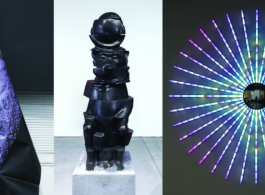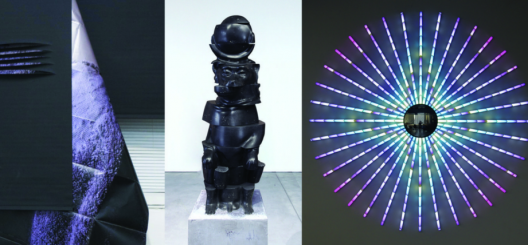‘Transmission’
Galerie Huit, Hong Kong
Galerie Huit is delighted to announce the group exhibition ‘Transmission’, featuring signature works by Gordon Cheung, Troika, James Clar, Doreen Chan and Alejandro Guijarro.
Transmission relates to the act of transference, its reception, to process, most commonly, a real time message. The exhibition will bring together a selection of artworks presenting a disruption of the visual narrative through a technological reworking of the familiar and archetypal; albeit classical painting, sculpture or photograph. Within the presented digital algorithmic paintings, reconfigured figurative sculptures, LED constructions, and monochrome c-prints, the new multimedia images and objects propose new interpretations.
At first glance, Cheung’s appropriations of Thomas Cole’s historical landscape paintings appear to be hand- painted pastiches using a blur brush technique. In fact, Cheung uses a digital algorithm that redistributes pixels.
The programmed ‘glitches’ create an image that appears to be erasing itself; a metaphor for history revising its past. As Cole’s original 19th Century romantic paintings depicted the rise and fall of a city. The flower painting ‘after Gerrit van Bloclant’ touches on the subject of the first economic bubble caused by Tulip mania during the Dutch Golden Age of the 17th Century. Cheung’s digital series revises the well-known tropes of landscape and vanitas painting for the 21st Century. The artist collective Troika also exercise the logic of algorithmic codes within their methodology. In contrast to Cheung, they commandeer an analogue approach to the realisation of their iconic works by probing the value of chance and the limits of algorithmic forecasting. ‘Reality is Not Always Probable’ is a two dimensional work that is created by hand and comprises thousands of 7mm ivory cube dice. It is constructed using a set of rules within a binary system. Although the rules instruct its creation and determine the choice of number on each dice, the overall pattern cannot be predicted. The iridescent copper tapestry ‘A Labyrinth of a Straight Line’ operates on the certainty of algorithmic data. Troika takes a recursive algorithm commonly used to search and navigate large amounts of data, once again following a set of simple rules, the algorithm traverses the expanse of canvas and manifests as a maze. Its path can be traced as a single continuous line, which becomes an infinite loop. Both the labyrinth and algorithmic technology are synonymous for technological mastery, predictability, control and order, and by reenacting this computing process to a human scale the artists draw the viewer into the loop. ‘Thoth’, a Jesmon ite sculpture modelled on the ancient god of magic and wisdom, is sliced and ‘re-stacked’. Utilising methods and emulating various processes of hacking, stacking and reordering digital data, the sculpture juxtaposes the objective, logical applications of science with the shifting nature of mythology and belief.
James Clar’s illuminating LED works creates an aperture from the energy of light. Although rare, there are somestars that emit blue light. The radiant‘Blue Star’ comprises 36 strips of light with a curved mirror in the centrethat reflects the surrounding environment of the viewer. The geometric patterns of light emanating from the centrepoint are of the blue spectrum. Clar propositions an alternative reality were the Sun to emit only blue rays, andthe unfamiliar found within a different frequency of light.‘Clouds’, a linear light piece reflects the environmentfrom a different perspective. Here, Clar visualises the motion of air currents, with hot air rising (indicated in red)and cold blue air sinking, light and shadow finds a representation of the invisible forces at work around us.A prescient piece ‘Earth’ is a luminescent topographical depiction and an amalgamation of visual and historicaldata – the familiar geography of the earth overlaid with a high resolution map of Mars. The composite illustratesa map of Earth in the distant future.Coming into a more personal narrative, Hong Kong based artist, Chan is inspired by, and collects images fromher everyday life.‘Rock’ comprises a black roller blind that obscures a window in the gallery. The blind is slashedto reveal a disheveled abstract print behind. The image is part of the artist’s personal archive, recorded by meansof iPhone, camera and other electronic devices. Bending the printed image and overlapping the blinds makes itimpossible to view the whole picture behind. Chan specifically manipulates the ‘partial scenes’ – they becomefixed and complete the photographic sculpture.Guijarro uses photography as a device to examine spatial relationships in photographic representations,exploring what photography is, both able to unable to do.‘Lead’, his most recent series was the result of fouryears researching X-rays and the digital scanning of Old Masters paintings from the most revered institutions inthe World. Having gained access to the conservation departments of The Louvre, The Prado Museum and TheNational Gallery, London, Guijarro additionally made infrared scans of the archival X-rays. This, a reinterpretationof the digital reading of the marks, repairs and traces of lead pigments presents anew, the famous figurative worksasGuijarro’s subliminal abstract images.Throughout the exhibition, the artworks demonstrate the capability of perpetual technological systems todetermine creative outcomes. Whilst Clar utilises the simple every day LED bulb and repurposes it to create afiction around the viewer andChan’s personal perspective is specifically censored by her own hand, we seewhen technology is applied to creation, it can generate profound questions for the artist – the reconstruction ofclassical narratives within the works of Cheung, Troika and Guijarro are articulated in different and unique ways.Their pieces are propelled by the selfsame innate creativity. The artists aptly exploit the democratic tools availableto communicate and reflect their unique responses to questions posed by humanity over the years.




